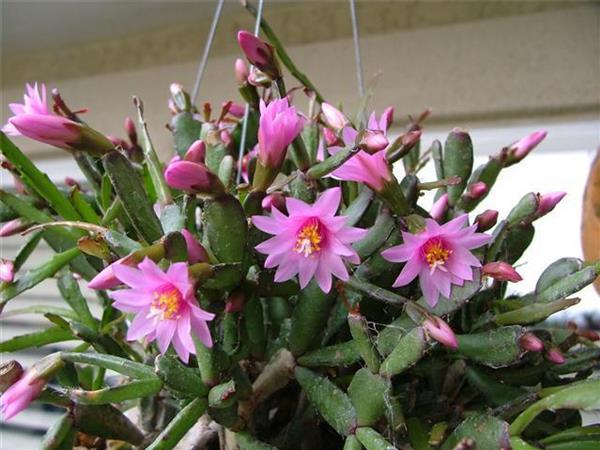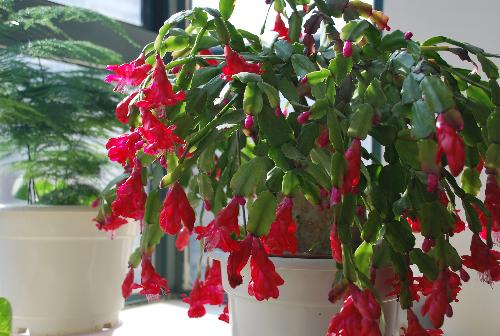[is the flower of crab claw orchid poisonous? is the flower of crab claw orchid poisonous?
Recently, many netizens have been talking about whether it is true that crab claw orchid is poisonous. So can crab claw orchid be raised in the bedroom? What are the functions of crab claw orchid? Is the flower of crab claw orchid toxic?
Is the flower of crab claw orchid poisonous?
First of all, tell you that crab claw orchid is non-toxic, can be maintained indoors, because crab claw orchid belongs to pulp plants, can absorb some indoor harmful air, we can rest assured to maintain.

Crab claw orchid varieties are bright red, pink, apricot yellow, and pure white. It is named crab claw orchid because the joint diameter is shaped like the secondary claw of a crab. The nodal stem is often overlong and overhanging, so it is often made into a hanging orchid for decoration. You can put it in the bedroom.
The role of crab claw orchid: detoxification and detumescence effect, indications: sore swelling poison; mumps. Nature: bitter; cold, entering the spleen and stomach meridians. Crab claw orchid blossoms on Christmas and New year's Day, the plant type hangs, the design is bright and lovely, suitable for windowsill, entrance and exhibition hall decoration, bustling, immediately full room glow. However, due to the way of feeding, some crab claw orchids are regulated to bloom in October.
The plant morphology of crab claw orchid: succulent plant, often shrubby, much branched. Flowering stems Lignified, slightly Terete, young branches and branches flattened; stem nodes short, oblong or nephew-ovate, 3-6cm long, 1.5-2.5cm wide, bright green, somewhat purplish when tender or in winter, apex truncate, with 2-4 thick and ±incurved serrations on each side, with thick middle ribs on both sides. Leafless. Peanuts at the top of tender stem nodes, rose-red, bilaterally symmetrical, 6-9 cm long; calyx 1-whorled, base connected with synthetic short tubular, apex dentate; petals several layers, lower long tubular, longer and longer toward inner tube, distally separated, exfoliated or dorsally curved; stamens numerous, 2 whorls, curved upward; style longer than stamens, crimson, stigma 6-9-lobed; ovary Pyriform or broadly ovoid. The berries are red, ca. 1cm in diameter.

The influence of Crab claw Orchid on Home Environment
The crab claw orchid, as its name suggests, is a very lovely plant. Crab claw orchid has a unique flavor even if it does not bloom. The stem of the crab claw orchid is flattened and leafy. The flower grows at the top of the stem and the perianth opens and curls. Green stem tip or red, or yellow, or lilac, or orange or pink flowers, appear delicate and unique.
There are many cultivated varieties of crab claw orchid. The common ones are white Christmas white, Dorsey, Gina, snowflakes, yellow golden beauty, Christmas flame, golden fantasy and so on. Crab claw orchid can effectively absorb carbon dioxide in the air and purify the air. The flowering period of crab claw orchid is from September to April of the following year, and the bright and gorgeous crab claw orchid brings people the smell of spring. No matter the day waiting for the flowers to bloom, or the days bathed in the faint flowers, it can make people feel happy. In particular, the crab claw orchid blossom coincides with these festive and lively festivals such as Christmas and New year's Day. the plant type hangs with bright and lovely colors, such as bright red, pink, apricot yellow, and pure white, which will be hung in the windowsill, the entrance of the doorway and the exhibition hall as decoration, which will immediately make the room full of glow. If modified or artificially controlled, some crab claw orchids can be regulated to bloom in October. The flowers are delicate and graceful, bright and beautiful, especially loved and praised by people.

The best way to propagate crab claw orchid is grafting, preferably in May-June or September-October. Cactus with cold tolerance and strong growth should be selected as rootstock. Two segments of sturdy and thick abnormal stem are selected as scions, and the lower end is cut into duckbill shape. Each rootstock can be grafted with 3 scions. Put it in a cool place after grafting, and if the scion remains fresh and straight after 10 days, it will survive. You will inadvertently gain a lot of unexpected fun in the process of taking care of him.
Put a pot of crab claw orchid in your room, you can't help feeling why such a pot of flowers will give you so many unexpected experiences and feelings.
Culture method of crab claw orchid
First, watering, crab claw orchids are not resistant to waterlogging, and if they are watered too much, they are extremely prone to rotting roots, so they must not accumulate water, and water should be watered again after the basin soil is dry, for example, once a week in winter. In addition, it is not advisable to spray water directly to the leaves.
Second, sunshine, crab claw orchid Xiguang is also very shady, the requirement for light is not high, indoor light can keep its normal growth, in summer, we must pay attention to prevent it from being directly exposed by the sun, otherwise it will be greatly damaged. In other seasons, as long as you put it in the window and other bright places, you can grow well, and put it in a shady place after flowering, which can prolong the flowering period.

Grafting method of crab claw orchid
The main results are as follows: (1) the cactus branches with one-year growth strip type, not too thick meat but exuberant growth and no diseases and insect pests are selected as rootstocks, and the length is between 8~12cm. Take it from the matrix, cut the lower end into a flat mouth, insert it into the sandy soil, cultivate it for 2-3 months, and then make a grafted rootstock after survival.
(2) the strong mother plant of crab claw orchid was selected, from which the tender top branch with nodes was selected as scion, and the length of the scion was 3~4cm (the growth potential of scion was weak after sprouting). Cut the lower sides of the scion into a wedge with an alcohol sterilized blade, and the cutting length is about 0.8~1.2cm.
Grafting method of crab claw orchid
The main results are as follows: (1) the cactus branches with one-year growth strip type, not too thick meat but exuberant growth and no diseases and insect pests are selected as rootstocks, and the length is between 8~12cm. Take it from the matrix, cut the lower end into a flat mouth, insert it into the sandy soil, cultivate it for 2-3 months, and then make a grafted rootstock after survival.
(2) the strong mother plant of crab claw orchid was selected, from which the tender top branch with nodes was selected as scion, and the length of the scion was 3~4cm (the growth potential of scion was weak after sprouting). Cut the lower sides of the scion into a wedge with an alcohol sterilized blade, and the cutting length is about 0.8~1.2cm.
Related
- Wuhan Hospital Iron Tree Blooming Result Was Instantly Frightened by the Gardener Master
- Which variety of camellia is the most fragrant and best? Which one do you like best?
- What is the small blue coat, the breeding methods and matters needing attention of the succulent plant
- Dormancy time and maintenance management of succulent plants during dormancy
- Minas succulent how to raise, Minas succulent plant pictures
- What are the varieties of winter succulent plants
- How to raise succulent plants in twelve rolls? let's take a look at some experience of breeding twelve rolls.
- Attention should be paid to water control for succulent plants during dormant period (winter and summer)
- Watering experience of twelve rolls of succulent plants
- Techniques for fertilizing succulent plants. An article will let you know how to fertilize succulent plants.



